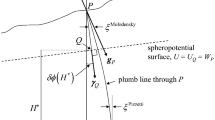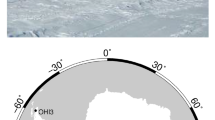Abstract
The Global Positioning System (GPS) is considered in conjunction with a strapdown Inertial Measurement Unit (IMU) for measuring the gravity vector. A comparison of this system in space and on an airborne platform shows the relative importance of each system element in these two different acceleration environments. With currently available instrumentation, the acceleration measurement accuracy is the deciding factor in space, while on an Earth-bound (including airborne) platform, the attitude error of the IMU is most critical. A simulation shows that GPS-derived accelerations in space can be accurate to better than 0.1mgal for a 30s integration time, leading to estimates of 1° mean gravity anomalies on the Earth's surface with an accuracy of 4–5 mgal. On an airborne platform, the horizontal gravity estimation error is tightly coupled to the attitude error of the platform, which can only be bounded by external attitude updates. Horizontal gravity errors of 5mgal are achievable if the attitude is maintained to an accuracy of 1arcsec.
Similar content being viewed by others
References
Blaha G (1991): Satellite-to-Satellite Tracking in the High-Low Mode: Line-of-Sight Acceleration in a Residual Gravity Field. PL-TR-91-2209, Phillips Laboratory (AFSC), Hanscom AFB, MA.
Carson L (1990): Preliminary Experimental Performance of the TOPEX Global Positioning System Demonstration Receiver (GPSDR). In: Proceedings of the Second Symposium on GPS Applications in Space, C. Jekeli (ed.), Report GL-TR-90-0032, Volume II, Geophysics Laboratory, Hanscom AFB, MA.
de Boor C (1978):A Practical Guide to Splines. Springer-Verlag, New York.
Eissfeller B, Spietz P (1989): Basic Filter Concepts for the Integration of GPS and an Inertial Ring Laser Gyro Strapdown System.Manus. Geodaetica,14, 166–182.
Hajela DP (1978): Improved Procedures for the Recovery of 5° Mean Gravity Anomalies from ATS-6/GEOS-3 Satellite to Satellite Range-Rate Observations Using Least Squares Collocation. Report No. 276,Department of Geodetic Science, Ohio State University, Report AFGL-TR-78-0260, Air Force Geophys. Lab., Hanscom AFB, MA.
Jekeli C, Upadhyay TN (1990): Gravity Estimation from STAGE, a Satellite-to-Satellite Tracking Mission.J. Geophys. Res.,95(B7), 10973–10985.
Jekeli C (1992): Balloon Gravimetry Using GPS and INS. Proceedings of the 1992 Position, Location, and Navigation (PLANS) Symposium, Monterey, CA, March 25–27.
King RW, Masters EG, Rizos C, Stolz A, Collins J (1985): Surveying With GPS. Monograph No.9, School of Surveying, University of New South Whales, Kensington, NSW, Australia.
Lazarewicz AR, Schilinski BJ, Cowie RJ, Rice CL, Moss P, Carter LN (1985): Balloon-Borne, High Altitude Gravimetry, The Flight of Ducky Ia (11 October 1983). Report AFGL-TR-85-0342, Air Force Geophysics Laboratory, Hanscom AFB, MA.
Lazarewicz AR, Schilinski BJ, Carter LN, Cowie RJ, Leyh C (1987): Balloon-Borne, High Altitude Gravimetry, The Flight of Ducky II (October 1985). Report AFGL-TR-87-0309, Air Force Geophysics Laboratory, Hanscom AFB, MA.
Schmidt GT (1978): Strapdown Inertial Systems — Theory and Applications — Introduction and Overview. In: Strap-Down Inertial Systems, AGARD Lecture Series 95, NATO, 7 rue Ancelle, 92200 Neuilly-sur-Seine, France.
Upadhyay TN, Priovolos G, Vander Velde WE, Rhodehamel H (1989): STS-GPS Tracking Experiment for Gravitation Estimation. Report AFGL-TR-89-0035, Air Force Geophysics Laboratory, Hanscom AFB, MA.
Author information
Authors and Affiliations
Rights and permissions
About this article
Cite this article
Jekeli, C. Vector gravimetry using GPS in free-fall and in an Earth-fixed frame. Bulletin Géodésique 66, 54–61 (1992). https://doi.org/10.1007/BF00806810
Received:
Accepted:
Published:
Issue Date:
DOI: https://doi.org/10.1007/BF00806810




